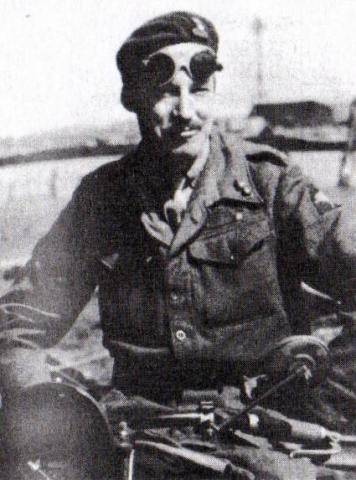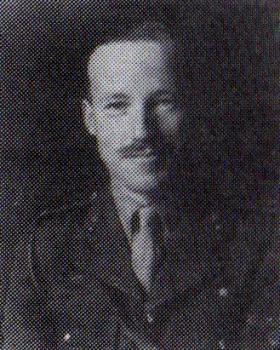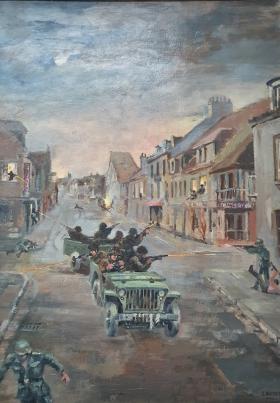John C A "Tim" Roseveare was born in 1914 and was educated at Hurstpierpoint College in West Sussex. He graduated with a first in Civil Engineering from King’s College, London in 1934. His father was also a civil engineer, and both father and son were involved in draining the Somerset Levels. Before the war, Tim joined the engineering firm of MG and RW Weeks. He later became a highly acclaimed engineer of international repute and a distinguished officer with the 3rd Parachute Squadron RE in Normandy 1944.
In 1939, Tim was commissioned into the Royal Engineers as a Lieutenant. He was quickly deployed to France but was forced into a hasty retreat from Dunkirk along with the rest of the BEF. From 1941-42 Captain Roseveare, who was now also known by the nickname "Rosie", was an instructor at 141 Officer Cadet Training Unit, Aldershot. Tim started his parachute jump training on the 25 January 1943 at RAF Ringway "Long Course" 48. Having finished by the 11 February, he was already interviewing other volunteers as Commander of the 3rd Parachute Squadron RE. Tim was remembered fondly in this role as a "small man with flowing locks, bushy moustache and piercing eye" who "commanded respect by his astute mentality, authoritative manner and control of basic English". These qualities would be amply demonstrated by Tim's heroism during the invasion of Normandy.
On D-Day, the 3rd Parachute Squadron was tasked with destroying five bridges across the River Dives. Tim was dropped 3 miles north of his intended drop zone with demolition charges and 500 lbs of plastic explosive, but no vehicles. From this position, destroying the bridge at Troarn must have seemed a herculean task. Nevertheless, Tim gathered 47 of his men and began the journey there on foot.
Fortunately for him, they encountered a jeep loaded with medical supplies on the way. Tim had "no compunction in commandeering it", driving it through Herouvillette and Escoville before emptying out the medicine and replacing it with just the charges. After Roseveare sent Tim Juckes to destroy the two bridges at Bures, he set off on the drive to Troarn himself, accompanied by Lieutenant David Breeze and eight other men. In the rear trailer with a Bren gun was Sapper Peachey, whilst Lance Sergeant Irving cleared barbed wire from the Jeep's path. Heavily laden with explosives, the vehicle could not move much faster than 30 mph, which became a problem when the Germans were alerted on the outskirts of Troarn. Under fire, Tim and his men may not have survived without the benefit of a steep downhill descent out of the village. However, the instability this caused in the trailer threw Peachey into the hands of the Germans, who took him prisoner. Major Shave later described how "Sergeant Hannah was, by this time, perched on the tow bar between the jeep and trailer; he swore that if he had not been there the trailer would have been lost".
Luckily, Tim reached the bridge soon after, detonating the Wade charges along the arches in an operation that "took less than five minutes". The bridge was completely destroyed by a second attack by The 8th Battalion the following morning. For his heroism in the early hours of D-Day, Tim was awarded the Distinguished Service Order (dated 31 August 1944 in the London Gazette).
Tim Roseveare continued to lead the 3rd Parachute Squadron with distinction for the rest of the war, fighting in the Ardennes and crossing the Rhine into Germany on the 24 March 1945. He was a member of the first Allied units to meet the Russians on the Baltic coast at Wismar.
After the war, Tim joined the consulting firm Dinnie, Beacon and Gourley and worked on the Tai Lam Chung Dam in Hong Kong from 1953-56. He joined Freeman and Fox Partners in 1957, becoming Project Engineer at the Festiniog hydroelectric power station in Wales. Tim travelled extensively for Freeman and Fox, becoming a partner in 1970 and receiving recognition from the Institution of Civil Engineers. One of the most accomplished engineers in the country, Tim was part of a panel charged with approving all dam construction in the UK.
Tim married Ursula Littlewood in 1940, with whom he had a son but later remarried Clare Sylvia Dixon-Smith in 1970. He died in November 2000.
Compiled with information from:
Pegasus Archive, Mark Hickman
Daily Telegraph Obituary
Pegasus Journal 2000
London Gazette
"Go To It", J.S.R. Shave
Article written by Alex Walker
Read More



Latest Comments
There are currently no comments for this content.
Add Comment
In order to add comments you must be registered with ParaData.
If you are currently a ParaData member please login.
If you are not currently a ParaData member but wish to get involved please register.